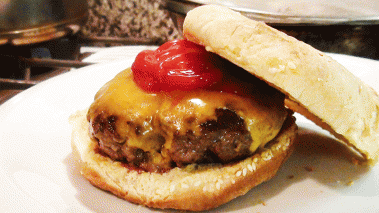Eight Tips to Cook the Perfect Burger
OK…before I catch too much grief about how wrong I am in my description of The Perfect Burger, allow me a few disclaimers. I love grilling burgers. If given the choice, I’d grill a burger over frying it. However, a poorly made and cooked burger, even over a grill is still going to be a crap burger. The tips below apply regardless of cooking technique. And frankly, many folks don’t have grills, and I will not subject them to a life with no burgers. Second disclaimer, there are all kinds of burger additions folks use to personalize a burger to their idea of perfection. Add your favorite spices, your favorite toppings, make the the patty a bit thicker, a bit thinner…there’s a ton of ways to customize the perfect burger…but I would still submit the tips below would apply to just about every one of those options, and followed properly will help ensure the end product is….Perfect.
Recipe Overview & Keys to Success for the Perfect Burger
1. Know the fat content of the meat and what it does. I like to use meat that is 80% lean for burgers. The fat in the meat provides more meaty flavor, and as it melts, more moisture. If you really want to use leaner meat, that’s fine. Just know you’re trading off a bit of flavor and moisture, and compensate for that. You can add a bit more seasoning to bump up the taste. You can cook the burger a shade less to help preserve more moisture
2. Season the meat before cooking. Generally I just like to use salt and pepper, but I’ve been know to throw in other spices, herbs, and even things like sautéed onion and mushrooms. With ground meat, you’ve got the opportunity to season all the way through the meat, not just the top and bottom, so take advantage of it.
3. Patty Formation. There are two big things to think about. Size and how much you work the meat. I don’t know if you like thick or thin, large or small burgers. You just need to know that thick burgers take longer to cook, and you need to adjust your cooking time accordingly. BTW – my one pet peeve is when the patty is shaped meatball like – make them puck shaped! By working the meat, I mean the amount you handle, mash, remash, squish and squash it. The more you handle the meat, the more it will be homogenious, which will give the burger a consistent texture through out, but it will also become tougher/more dense. Less handling will give you a more tender burger. It’s a matter or preference.
4. Cook room temperature burgers. Like just about any meat, you want the burgers to be at room temperature when you start cooking them. That makes it easier to get to a point where you’ve got a nice seared outside, and an internal temperature where you want it (from rare to well done). To cook the burger rare, you actually want to start off with higher heat, and cook for less time. Doing so will allow the outside of the burgers to get nice cooked, while limiting the amount of heat that gets to the center, keeping it under well done. Use a bit lower heat and longer cooking for well done burgers.
5. Flip them once. A common theme I see with burger makers is they are constantly flipping, and again, like most meats, that’s a mistake. A burger needs to be flipped once. Lay them down in the pan, or on the grill, and allow that side to sear. You can cook the burger about 60% of the way on this one side. Once that side is well seared, flip it to allow the other side to sear and leave it at that. For rare burgers, cook very hot, but very quickly. For well done burgers, still cook hot (just not very hot), but let them cook on each side longer)
6. Press them? The urge to press down on the burger is nearly irresistible. First, I’ll say definitively, there is no need to press on the burger. What you’re doing is driving juice from the meat. I won’t say definitively you shouldn’t do it, because I know some people like dryer burgers. If you’re one, go ahead and press just know that you're getting a drier burger. I never press.
7. Cheese? I just about always throw some cheese on my burger, but to be good, it has to be melted. I’ll generally add the cheese just after the first (and only) flip and then cover up the burgers to create an oven like effect that melts the cheese. On the grill, just close the lid. On the stove top, you can use a lid, or if you don’t have one, just throw a bowl over the top like I do in the recipe video.
8. Let them rest. Once cooked, just like any meat, the juice inside the burger is very “active”, flowing freely and zipping around. Bitting into the burger right then is going to let more of that juice flow out, right onto the bun, making it soggy. So, let them rest for a couple minutes before serving.
And there you’ve got it…the Perfect Burger. Hope you enjoy it!
Wine Recommendation: You can server just about any wine with a good burger, and you may want the toppings, sauces and sides to drive your choice. For a pretty standard cheese burger, I like Zinfandels if I'm in the mood for a bigger, full bodied wine, or Pinot Noir for a ligher wine.

Comments (4 )